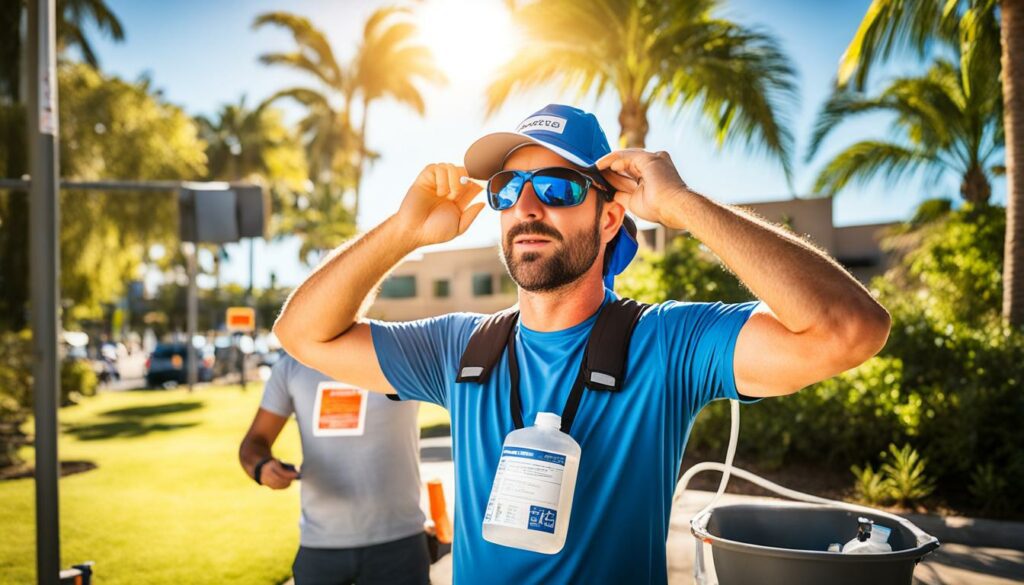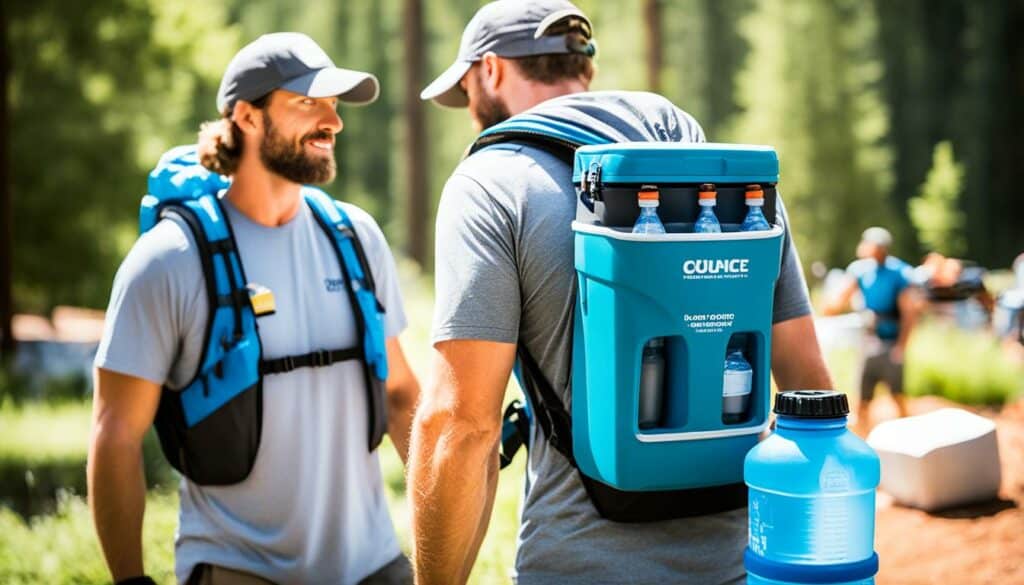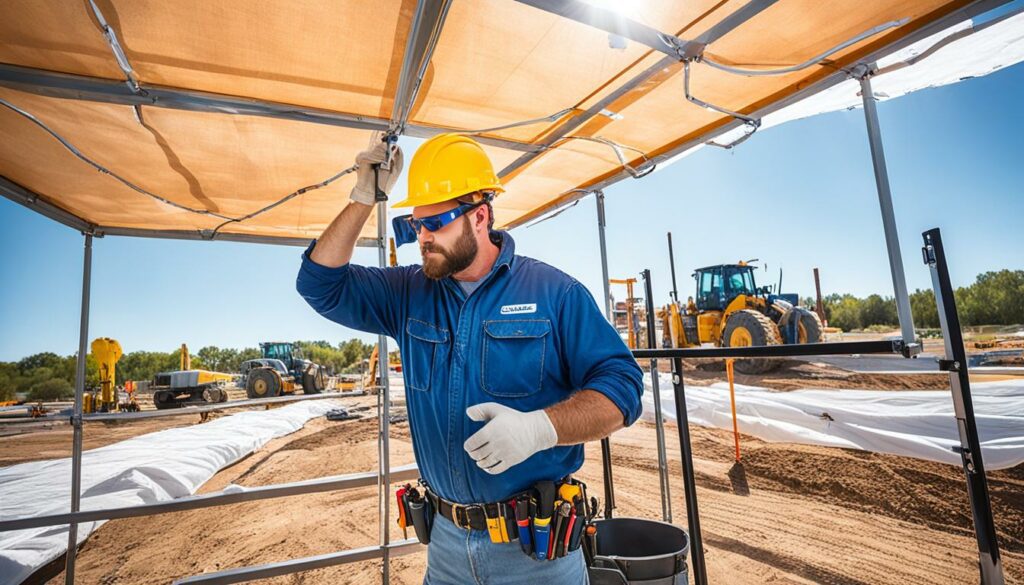Menu

Have you ever thought about how many lives could be saved if we protected all outdoor workers from heat stress? Millions of U.S. workers face big dangers from extreme heat each year. Often, heat-related deaths come in the first few days of working in hot conditions. This is a big problem in jobs like farming, building, gardening, and working with oil and gas wells. It’s crucial to manage how much heat workers face.
This problem is very serious because it can lead to less work getting done, workers going to the hospital, and in the worst cases, death. Employers, especially in states that have special rules about heat like Washington, Minnesota, California, Oregon, and Colorado, play a key part. They need to make sure their workers are safe from the heat. They can do this by helping workers get used to the heat slowly, making sure they drink enough water, and giving them breaks to rest. They should watch for any signs that a worker might be getting too hot.
There are ways to make working in extreme heat safer. Employers can do things like increasing airflow, using shields that reflect the heat, and following advice from OSHA about how to measure and manage heat risks. By using these methods, it’s possible to keep workers safe even when it’s very hot outside.
It’s important to know what heat stress is to keep outdoor workers safe. It happens when the body can’t get rid of heat well. This makes the body’s temperature go up. High air temperature and humidity, plus hard work, make it worse. So, knowing how to cool down is vital.
The technical definition of heat stress is a situation where the body struggles to cool off properly. This leads to the body’s temperature rising too much. It’s caused by hot weather, hard work, and not being used to the heat. Knowing how to deal with it is crucial, especially for those who work outside.
Our bodies have ways to deal with getting too hot. The main ways are by sweating and sending more blood to the skin. This lets heat escape as sweat evaporates and as heat comes off the skin. But, high humidity and hard work make it harder. So, making sure there’s enough air moving can really help cool us down.
With global temperatures on the rise, it’s very important to know about heat-related sickness. This is key for outdoor workers, sports players, or those who love the sun. Understanding the dangers is crucial.

Heat exhaustion is common among older adults, people with high blood pressure, and workers in the heat. Symptoms of heat exhaustion include headache, nausea, dizziness, and heavy sweating. Drink lots of water, wear light clothes, and rest in the shade to prevent it.
Heat stroke is very serious and needs immediate medical help. The body can quickly reach a temperature of 106°F or more. Signs of heat stroke are confusion, slurred speech, and even seizures. Be ready to act fast by staying cool, drinking water, and watching for symptoms.
Heat rash is a common problem for people working in hot places. It looks like red pimples and blisters in sweaty areas. It’s key to recognise heat rash early.
The table below shows symptoms and how to prevent different heat-related illnesses:
| Condition | Symptoms | Prevention Measures |
|---|---|---|
| Heat Exhaustion | Headache, nausea, dizziness, weakness, irritability, thirst, heavy sweating | Stay hydrated, wear light clothing, take breaks in shady areas |
| Heat Stroke | Confusion, altered mental status, high body temperature, seizures | Maintain hydration, acclimatise, recognise early symptoms |
| Heat Rash | Red clusters of pimples or blisters on neck, chest, groin | Avoid excessive sweating, keep skin dry, wear breathable clothing |
Knowing how to prevent heat exhaustion, avoid heat stroke, and spot heat rash is vital for anyone at risk. Stay safe by staying informed and talking to a doctor.
Every year, many U.S. workers face the dangers of heat at their jobs. This hazard leads to thousands becoming ill, with some facing fatal consequences. To keep outdoor employees safe, a mix of strategies is key. This approach combines changes in the working environment, the way tasks are planned, and an educational push.
Engineering controls introduce measures like air conditioning and better air circulation. These efforts lower the workplace’s temperature, which helps in reducing heat illnesses. It’s also smart to schedule heavy tasks when it’s cooler.
Administrative controls work on helping workers get used to the heat and stay hydrated. Employers should let workers adapt slowly to hot conditions, usually over 7 to 14 days. This is important because most heat-related deaths occur at the start. It’s critical that new workers aren’t pushed too hard in the heat on their first day.
Employers in places like Washington, Minnesota, California, Oregon, and Colorado must follow strict rules. They have to ensure the workplace is safe from heat dangers. This underlines the key part that controlling heat plays in safeguarding outdoor workers.
| State | Specific Laws for Heat Exposure |
|---|---|
| Washington | Yes |
| Minnesota | Yes |
| California | Yes |
| Oregon | Yes |
| Colorado | Yes |
By using all the heat stress prevention tips together, and strictly following laws, employers make the workplace safer. This activity plays a huge role in cutting down illnesses and deaths caused by heat.
Ensuring workplace heat safety is vital for employers, especially in hot industries. These include construction, refining, and working in hazardous areas. Employees in these fields are more likely to suffer from heat stress. This is because they work outside in high temperatures. To keep workers healthy, strict occupational heat safety protocols are essential.

“Employers should provide adequate amounts of cool, potable water near the work area and encourage workers to drink often.”
Key to preventing heat-related illness is to keep workers hydrated. Those doing moderate tasks in heat need to drink a cup of water every 15-20 minutes. But, they shouldn’t drink more than six cups per hour to avoid issues like overhydration.
Good occupational heat safety plans teach workers to spot and deal with heat stress symptoms. Signs include headache, weakness, and thirst, which might indicate heat exhaustion. If someone gets confused or faints, they might be having a heat stroke. This requires immediate medical help.
Using technical and organizing methods can also cut the risk of heat stress. Measures like better ventilation, air cooling, and more air flow work well. Setting up heat alert plans in extreme weather also boosts safety.
| Heat-related Illness | Signs and Symptoms | Prevention Strategies |
|---|---|---|
| Heat Stroke | Confusion, loss of consciousness, convulsions (temperatures as high as 105.8°F/41°C) | Immediate cooling, emergency medical attention |
| Heat Exhaustion | Headache, weakness, thirst | Rest, hydration, cooling strategies |
| Heat Cramps | Muscle cramps due to electrolyte imbalance | Hydration with electrolyte replacement |
| Heat Rash | Red papules, prickling sensation | Keep skin dry, clean, and cool |
Acclimatisation happens when our body learns to handle heat bit by bit. This is key for staying safe in hot jobs. Workers, whether new or returning, must get used to the heat slowly.
In 2005, Cal/OSHA found a lot of heat illness cases happened early on the job. To avoid this, a set plan for getting used to the heat is wise. Both NIOSH and experts advise starting slowly and increasing exposure day by day.
| Day | Work Duration |
|---|---|
| 1st day | 20% of usual work duration |
| 2nd day | 40% of usual work duration |
| 3rd day | 60% of usual work duration |
| 4th day | 80% of usual work duration |
| 5th day | 100% of usual work duration |
For those who’ve been in similar heat, things move a bit faster. They start at 50% and reach 100% within four days. Being fit helps a lot, making acclimatisation happen around twice as fast.
Getting used to the heat takes about 7 to 14 days, for at least two hours daily. During this time, our body learns to cool down better and keep fluids balanced. Even after fully acclimatising, improvements keep happening for two more weeks.
It’s important for employers to know the risks, like body fat and fitness levels, in the heat. Overweight workers and less fit workers find it harder to cool down, which makes them more at risk from the heat. This can even affect how well they think and remember things. Practices like the U.S. Armed Forces’ program, TB MED 507, show that daily heat exposure can help a lot.
Adding acclimatisation into safety measures helps workers tackle their hot work settings better. This also cuts down the chances of getting sick from the heat.
Good hydration is key to keeping outdoor workers safe and effective. They are at risk of heat stress. By avoiding dehydration and balancing water and electrolytes, workers can stay strong and sharp in hot conditions.
Keeping the right balance of electrolytes is vital, especially to stop dehydration in hot conditions. The body loses a lot of salts through sweat, so they need regular topping up. For heavy sweating, like during work, NIOSH actually recommends sports drinks over salty food or salt tablets. Also, it’s best to skip alcohol 24 hours before hot work to stay safe from heat illnesses.

Working out how much water workers should drink is critical. The advice is to have 1 cup (8 ounces) every 15-20 minutes in the heat. This regular, small amount keeps you hydrated better than drinking a lot at once. Typically, women are told to drink 2.7 litres a day, and men 3.7 litres. Most of this should be from drinks, not food.
| Hydration Guideline | Women | Men |
|---|---|---|
| Daily Water Intake | 2.7 litres | 3.7 litres |
| Frequency During Heat | 1 cup every 15-20 minutes | |
| Fluid Sources | 80% from drinking water, 20% from food | |
The American Council on Exercise highlights the crucial role of smart drinking around activities. These tips are useful for companies to keep their workers hydrated:
Employers should provide plenty of drink options and teach their workers about the value of steady fluid intake. This approach will help protect their team’s health and keep them working well.
Effective planning and supervision keep workers safe from heat stress. A detailed heat risk control plan is needed. It should include checks on the weather, how well workers are used to the heat, rest times, and what to do in emergencies.
The Occupational Safety and Health Administration (OSHA) is leading the fight. It started the National Emphasis Program (NEP) for heat stress on April 8, 2022. The NEP focuses on stopping heat illnesses when it’s over 80°F. It urges employers to make plans to keep their workers cool and safe.
Teaching about heat stress is key. All workers and their bosses need to know the signs and what to do. They also need to understand how important it is to drink enough water. Knowing these things helps make the workplace safer.
Employers must do their part, too. OSHA checks their records and how they handle heat stress during visits. They suggest using things like the ReflectIR™ Thermal Barrier in the MSA V-Gard C1™ Hard Hat. This tech can lower the temperature inside the hard hat by up to 20°F.
Getting used to the heat is also very important. Workers should slowly get used to working in the heat. It’s good for new workers to have someone to look after them, especially when it’s very hot. This gives new workers someone to turn to for help if they need it.
By making heat stress prevention part of everyday plans, and making sure each person knows what they should do, we can cut down the risk a lot. This makes the workplace both safe and efficient.
Employers can cut down on heat stress at work by redesigning spaces. This means changing the work area to lower the chance of heat exposure. It makes the workplace safer, especially for workers dealing with high temperatures.

Air conditioning is a game-changer for many workplaces. It drops the air temperature significantly. This makes it more comfortable for employees. It also supports how the body naturally cools off when it’s really hot outside.
Improving ventilation is key. It uses fans or natural ways to get more air moving. This step helps to eliminate heat stress by making sure the air doesn’t get too hot in one place. With better air circulation, workers can do their jobs without feeling the worst of the heat.
It’s crucial for bosses to look at the jobs being done and bring in these changes where needed. This is the best way to keep people working safely and well in hot conditions.
Administrative controls can make a big difference in how safe and productive outdoor workers are during hot weather. They involve things like changing work hours and making sure workers have enough breaks.
Changing work hours to avoid the hottest times is key in managing heat exposure. By doing this, the risk of heat stress goes down. For example, doing hard work early in the morning or late at night is better.
By planning work times wisely, less heat hits the workers. This makes the jobs easier and safer to do.
Having set rest breaks is also really important. It’s a key way to stop workers getting too hot and ill. Research tells us that these breaks, taken in the shade or in a cool place, help keep the body cool. This means fewer heat-related illnesses.
Making these breaks a must for every worker is essential. It helps protect their health.
It’s also crucial to consider that not all workers get used to the heat in the same way. So, new workers or those who’ve been away need time to get used to it again. They should start with easier tasks and work up. Also, making sure they drink enough water is very important during any activity.
Following these administrative controls means more than just obeying rules. It’s about looking ahead and protecting the health and work output of those who work outside when it’s very hot.
Personal Protective Equipment (PPE) is key in keeping outdoor workers safe from heat illnesses. By using cool vests and lightweight, breathable clothing, workers can stay safer in the heat.
Cooling vests have changed how we protect workers from the heat. They use special materials or water to keep the body cool. Studies show these vests are great at preventing heat stress. There are different types, like ice vests which are cheaper, and water-cooled vests which are very effective but can limit movement.

Using light, breathable materials is crucial in the fight against heat. These fabrics let air through and pull moisture away from the skin. This helps cool the body down. Wearing clothes made of these materials can lower body temperature, reducing heat illness risk.
Adding these fabrics to everyday PPE can make a big difference. It makes workers more comfortable without sacrificing safety. Employers can pick the best fabrics and cooling tech to make sure their teams are safe from the heat.
Teaching workers about heat stress and how to stay safe is key. They need to know about the environment and their body’s reactions to heat. They should learn how to prevent problems and what to do if someone is feeling too hot.
It’s important for workers to know the first signs of getting too hot. Employers should make sure they know what to do in an emergency. This includes how to help someone with heat stroke or heat exhaustion.
Workers must slowly get used to working in the heat. New workers start at 20% effort, then increase daily. Experienced workers begin at 50% and reach 100% by the fourth day. This reduces the risk for everyone.
Drinking water is crucial for staying cool. Workers should have a cup of water every 15-20 minutes in the heat. For long, sweaty jobs, they should switch to sports drinks. It’s also vital not to drink more than six cups of water per hour.
It’s vital for workers to take breaks in hot weather. Employers should plan work and rest times wisely. This helps keep workers safe. Lighter work and longer breaks are especially necessary for new or unprepared workers.
Heat stress training helps workers stay safe. It lowers the chance of them getting sick from the heat. This makes the workplace better for everyone.
| Accrual of Workload | New Workers | Experienced Workers |
|---|---|---|
| Day 1 | 20% | 50% |
| Day 4 | Increments Daily | 100% |
It’s vital to spot early signs of heat-related illnesses fast. The CDC says 702 people die from heat each year in the U.S. Seeing these symptoms early can help save lives.
Noticing heat stress symptoms early is crucial. People in cities, hot areas, the old, and the young are at risk. Signs like heavy sweating and feeling tired show up first.
Get help quickly if you see someone with these symptoms. Put them in a cool place and cool them down fast. Use wet cloths and fans for this. Stay updated with heat warnings from NWS and OSHA through weather.gov or local news.
For heat exhaustion, they need medical help fast to avoid serious harm. Over 326,497 have had heat illness treatments in emergency rooms. Training workers and bosses to act quickly is very important.
Heat stress is when your body can’t cool down enough. This makes your internal temperature rise. It happens in hot weather, when you’re working hard, or if you’re not used to the heat.
Your body cools by sweating and sending more blood to your skin. But, this doesn’t work as well when it’s very hot, humid, or you’re exercising hard without getting used to it first.
Three main illnesses come from heat: heat exhaustion, heat stroke, and heat rash. Heat exhaustion makes you thirsty, cranky, and your muscles might cramp. But heat stroke is more severe, making you confused or pass out. It needs urgent help. If you sweat a lot for a long time, you could also get a heat rash.
To avoid heat stress, outdoor workers should drink plenty, take regular breaks, get used to the heat slowly, and watch for signs of getting too hot. Bosses can help by making the workplace cooler and adjusting when and how people work.
Bosses should set rules for keeping hydrated, taking breaks, and getting used to the heat. It’s also key to teach workers about heat stress signs and to use things like AC and changing work hours to keep everyone safe.
When people get used to the heat gradually, it’s called acclimatisation. Starting with shorter shifts and slowly increasing time, along with staying hydrated and resting enough, helps workers get used to heat safely.
Drinking enough is vital to keep your body’s water and salt balance right, especially when you’re sweating a lot. Employers should make sure workers can easily get enough fluids, considering how tough their job is and how hot it is.
Good planning means checking the weather, knowing how used the workers are to heat, and creating a work-break plan that fits. Supervisors should keep an eye out for signs of heat stress and know what to do if it gets serious.
Installing air conditioning and improving air circulation can make a big difference in reducing heat risks. These steps help cool the air and support the body’s natural cooling.
To lower the heat stress risk, employers can change when people work to cooler times, make the jobs less intense or shorter, and make sure everyone takes breaks in the shade. This helps keep people cooler.
Things like cooling vests and clothes that breathe keep the body cool and lower the risk of heat issues. This lets workers do their job in high temperatures more safely.
Knowing about heat stress and how to act can save lives. Trained workers can spot the danger signs early and help each other before things get really bad.
Spotting heat stress early means noticing things like heavy sweating, feeling very tired, or being confused. If this happens, get the person to a cool place, give them plenty to drink, and try to cool them down to stop it getting worse.